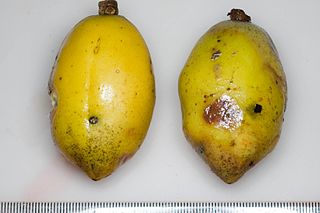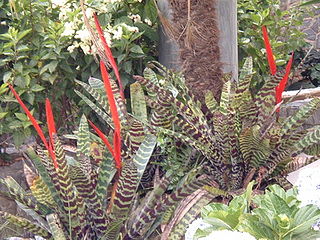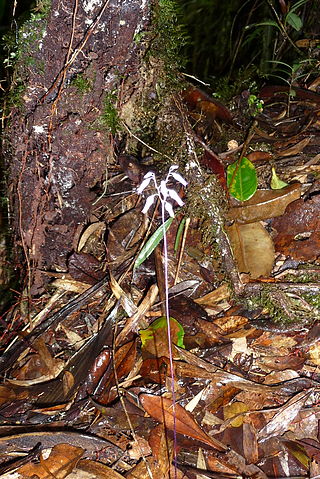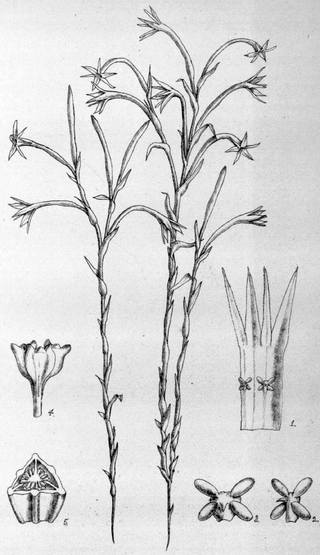Conceveiba is a plant genus of the family Euphorbiaceae, first described as a genus in 1775. It is native to South America and Central America.
- Conceveiba guianensisAubl. - Brazil, Peru, Bolivia, Ecuador, Colombia, Venezuela, 3 Guianas
- Conceveiba hostmaniiBenth. - Guyana, Suriname, Amazonas State in Brazil
- Conceveiba krukoffiiSteyerm. - Venezuela, French Guiana, NW Brazil
- Conceveiba latifoliaBenth. - Colombia, Venezuela, Peru, Amazonas State in Brazil
- Conceveiba martianaBaill. - Venezuela, French Guiana, NW Brazil, Colombia, Ecuador, Peru, Bolivia
- Conceveiba maynasensisSecco - Loreto in Peru
- Conceveiba parvifoliaMcPherson - Panama, NW Colombia
- Conceveiba pleiostemonaDonn.Sm. - Costa Rica, Nicaragua, Colombia, Venezuela
- Conceveiba praealta(Croizat) Punt ex J.Murillo - NW Brazil
- Conceveiba ptariana(Steyerm.) Jabl. - S Venezuela
- Conceveiba rhytidocarpaMüll.Arg. - Colombia, Ecuador, Peru
- Conceveiba santanderensisJ.Murillo - NW Colombia
- Conceveiba terminalis(Baill.) Müll.Arg. - Venezuela, Guyana, Suriname, NW Brazil, Colombia, Peru
- Conceveiba tristigmataJ.Murillo - Colombia, Venezuela, NW Brazil
Caryodendron is a plant genus of the family Euphorbiaceae first described as a genus in 1860. The genus includes C. orinocense, known as the Inchi tree or Tacay nut. It is native to Central America and South America. They are dioecious trees.
- Caryodendron amazonicumDucke - Amazonas in Brazil
- Caryodendron angustifoliumStandl. - Costa Rica, Panama, Colombia
- Caryodendron janeirenseMüll.Arg. - Rio de Janeiro
- Caryodendron orinocenseH.Karst - Colombia, Venezuela, Ecuador
Philyra is a plant genus of the family Euphorbiaceae first described as a genus in 1841. It contains only one known species, Philyra brasiliensis, native to Brazil, Paraguay, and northeastern Argentina.
Astrococcus is a genus of plant of the family Euphorbiaceae first described as a genus in 1854. It contains only one known species, Astrococcus cornutus, native to neighboring states of identical names, Amazonas State in southern Venezuela and Amazonas State in northwestern Brazil.
Haematostemon is a genus of plant of the family Euphorbiaceae first described as a genus in 1919. It is native to northeastern South America.
- Haematostemon coriaceus(Baill.) Pax & K.Hoffm. - Amazonas State in S Venezuela
- Haematostemon guianensisSandwith - Potaro-Siparuni region of Guyana
Sphaerostylis is a genus of plant of the family Euphorbiaceae first described as a genus in 1858. The entire genus is endemic to Madagascar.
- Sphaerostylis perrieriLeandri
- Sphaerostylis tulasneanaBaill.

Glycydendron is a genus of plants, under the family Euphorbiaceae first described as a genus in 1922. It is native to South America.
- Glycydendron amazonicumDucke - French Guinea, Suriname, Guyana, Ecuador, Peru, Bolivia, northwestern Brazil, possibly Colombia
- Glycydendron espiritosantenseKuhlm, - State of Espirito Santo in Brazil

Garcia is a plant genus of the family Euphorbiaceae and of the monotypic subtribe Garciinae, first described as a genus in 1792. It is native to Central America, Mexico, Colombia, and Venezuela, and also naturalized in some of the West Indies.
- Garcia nutansVahl ex Rohr - Mexico from Sinaloa and San Luis Potosí to Chiapas + Yucatán, Central America, Colombia, Venezuela
- Garcia parvifloraLundell - Chiapas, Tabasco, Veracruz
Dendrothrix is a plant genus of the family Euphorbiaceae first described as a genus in 1996. It is native to southern Venezuela and northwestern Brazil.
- Dendrothrix multiglandulosaEsser - Amazonas State in Venezuela
- Dendrothrix wurdackiiEsser - Amazonas State in Brazil
- Dendrothrix yutajensis(Jabl.) Esser - Amazonas State in Brazil; Amazonas & Bolívar States in Venezuela
Pseudosenefeldera is a plant genus of the family Euphorbiaceae first described as a genus in 2001. It contains only one known species, Pseudosenefeldera inclinata, native to Panama and to northern and west-central South America.
Rhodothyrsus is a plant genus of the family Euphorbiaceae, first described as a genus in 1999. It is native to South America.
- Rhodothyrsus hirsutusEsser - Colombia, NW Venezuela
- Rhodothyrsus macrophyllus(Ducke) Esser - Guyana, Suriname, Colombia, Peru, N Brazil

Dalechampia dioscoreifolia is a species of plant in the family Euphorbiaceae first described in 1841. It is native to Central America and northern and western South America.

Vriesea splendens, or flaming sword, is a species of flowering plant in the family Bromeliaceae, subfamily Tillandsioideae. Native to Trinidad, eastern Venezuela and the Guianas these plants were introduced to Europe in 1840. This species of Vriesea features smooth-margined foliage with brown bands growing in a rosette, usually producing a bright red inflorescence in a flattened spike. It is a recipient of the Royal Horticultural Society's Award of Garden Merit.

Tonina fluviatilis is a plant species in the Eriocaulaceae. It is the sole species in the monotypic genus Tonina, native to southern Mexico, Central America, northern South America, Cuba and Trinidad.
Euterpe catinga is a palm species in the genus Euterpe. It is found in forests of a dry, sandy soil and very peculiar vegetation, known as catinga forests or Campinarana in northern South America.
Nietneria is a genus of plants in the Nartheciaceae. It has two known species, both native to northern South America.
Miersiella is a monotypic genus of flowering plants in the Burmanniaceae, first described as a genus in 1903. It contains only one known species, Miersiella umbellataUrb. It is native to South America.

Dictyostega is a genus of flowering plants in the Burmanniaceae, first described as a genus in 1840. It contains only one known species, Dictyostega orobanchoides, native to southern Mexico, Central America, Trinidad, and South America ).

Campylosiphon is a genus of flowering plants in the Burmanniaceae, first described as a genus in 1882. It is native to tropical western and central Africa, as well as northern South America.

Apteria is a genus of flowering plants in the Burmanniaceae, first described as a genus in 1834. It contains only one known species, Apteria aphylla, the nodding-nixie, native to the southern United States, Mexico, Central America, the West Indies, and South America.








